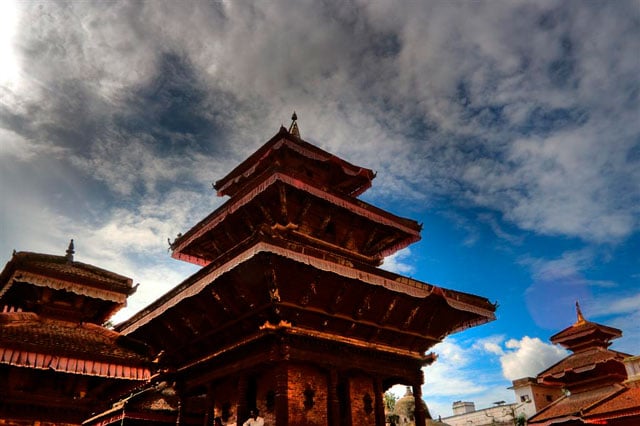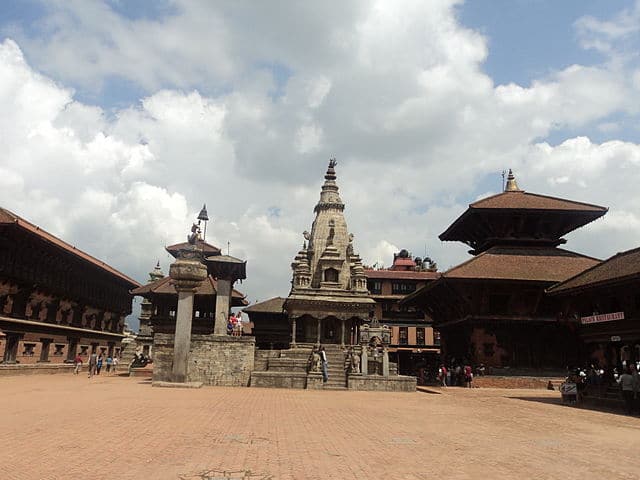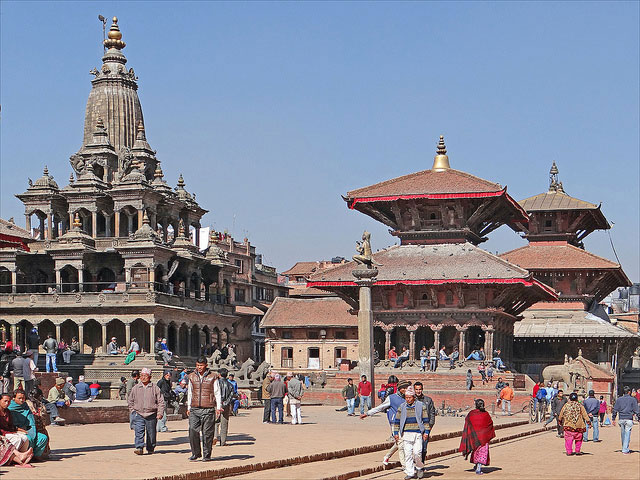Durbar Square refers to the places near Nepal’s royal palaces of the past. Temples, idols, statues, open courts and fountains along with other structures form part of Durbar Square. In the past Durbar Squares had been witness to events of importance including coronation of kings of the land. Now united as one country, Nepal was once a land that consisted many small kingdoms. Durbar Squares are fine examples of the life and style of the ancient kingdom. The famous three Durbar Squares in Nepal are Kathmandu Durbar Square, Patan Durbar Square and Bhaktapur Durbar Square. UNESCO has declared these squares as World Heritage Sites.
1. Kathmandu Durbar Square

It is also famously called as Basantapur Durbar Square and Hanuman Dhoka Durbar Square. Located in front of Kathmandu’s royal palace, this spectacular Durbar Square reflects the artistry that prevailed in the past. Kathmandu Durbar Square houses palaces and ancient temples that belong to the periods between 12th and 18th centuries. The cultural spirit of Nepal centers in Kathmandu Valley and hence Kathmandu Durbar Square gains more prominence. It consists of two divisions, which are referred to as outer complex and inner complex. The outer complex has famous temples namely Taleju Temple, Jagannath Temple, Shiv-Parvati Temple, Big Bell and Kumari Bahal. The inner complex has old palace, courtyards, Basantapur Durbar, Hanuman Dhoka and other structures. The palace in the complex was the residence of the Nepalese Royal family until 19th century and coronation of kings took place here. The temples representing Hindu and Buddhist faiths are constructed in pagoda style. The stunning architecture involved in the construction of temples and palaces in Kathmandu Durbar Square makes the place one of the most frequented tourist destinations. No wonder, Kathmandu Durbar Square ranks amongst the eight Cultural World Heritage sites. Some of the important places in Kathmandu Durbar Square are:
Taleju Temple: The first three-tired temple of the land, Taleju Temple, is considered an important religious site by followers of Hinduism and Jainism. Legend goes that Goddess Taleju had appeared before the king in the form of bee to advice that the temple be built resembling the design of yantra.
Jagannath Temple: Jagannath Temple was initially dedicated to Lord Vishnu and later it was re-dedicated to Lord Jagannath. The temple is a fine example of architectural splendor of the past. Exquisite carvings on the doors and windows are an inspiration to any artistic mind.
Shiv-Parvati Temple: It is one of the famous temples in Kathmandu Square Durbar. Dedicated to Shiva and Parvati, the temple is believed to be reconstructed later.
Kumari Bahal: Kumari Bahal is the abode of Living Goddess. Built in the year 1757, it resembles a monastery. A girl chosen to be living goddess of the town lives in the place until she reaches puberty after which she returns to her normal life.
Bhandarkal: Bhandarkal is yet another attraction in Kathmandu Durbar Square. It is a botanical garden established by King Pratap Mall during 17th century. The garden earns its name after a palace that houses the statue of Jalashayana Narayan, the Sleeping Vishnu. With wide range of fauna, Bhandarkal is haven for nature lovers.
2. Patan Durbar Square
Patan, also known as Lalitpur, is located on the south of Bagmati River and it is one amongst the three royal cities in Kathmandu valley. It is also the oldest among the three cities. Patan Durbar Square has been declared as World Heritage Site by UNESCO. Famous for its rich cultural heritage, Patan is home to fine arts. The splendid woodcarvings and metal statues speak stories of the skills of artisans. Considered to be established during the 3rd century BC, Patan is a cultural center where many festivals are celebrated every year. Four Ashoka Stupas built in four cardinal points of Patan are considered very important architectural treasures of the land. The Stupas are said to be built by Emperor Ashoka during 250 BC. Temples, palaces, statues and stone baths are some of the constructions found in Patan Durbar Square. Given below are some of the famous places in Patan Durbar Square.
Hiranya Varna Mahavihar: Also referred to as the Golden Temple, Hiranya Varna Mahavihar was built by King Bhaskar Verma during 12th century. The golden façade of the three-storied Pagoda looks stunningly beautiful. Buddha’s golden images and wall carvings are found inside the temple.
Patan Museum: Patan Museum ranks among the best museums in the Asian continent. The museum is situated in an ancient palace, which dates back to 1734. The collections in the museum depict the rich cultural history of Nepal. Most of the collections are bronze statues and gilt copper objects. The garden adjacent to the museum offers a pleasant sight and a peaceful resting place.
Patan Zoo: Nepal’s only Zoo, Patan Zoo, was established in the year 1932. Initially a private zoo, the year 1956 saw the zoo opened to public. The zoo is home to more than 700 species of animals, which include 14 endangered animals in Nepal. The pond in the zoo offers boating facilities.
Godavari Botanical Garden: Godavari Botanical Garden is situated on the southern side of Patan Durbar Square. The garden has a wide range of plants and the dense forest offers great scope for bird watching and hiking. It is also a famous picnic spot.
Kumbeshwor Temple: Kumbeshwor Temple is one among the two 5-tier temples in Nepal. It is dedicated to Lord Shiva. The temple dates back to 1391 and it was initially a two-tiered construction. The natural spring inside the temple is considered to come from the famous Gosainkunda Lake.
3. Bhaktapur Durbar Square

Bhaktapur Durbar Square presents a combination of pagoda and shikhara style of temples. The place is an architect’s delight as it is a fine specimen of sculptures and woodcarvings. The temples are located around the fifty-five window palace made of brick and wood. Bhaktapur Durbar Museum represents the traditional art of Nepal. The ancient city engages you with a fine display of magnificent local products, pottery, and various other artworks apart from the beautiful temples. Some of the most important places in Bhaktapur Durbar Square are:
55 Window Palace: Dating back to 15th century AD, 55 Window Palace is a marvelous construction that displays architectural splendor in a very fine form. It was built by King Yakshay Malla and later was renovated by King Bhupatindra Malla during 17th century. The palace derives its name from the unique construction of 55 windows in a balcony, which is a fine example of woodcarving.
The Golden Gate: The main entrance to the courtyard of ancient palace of 55 Windows, Golden Gate, is an awe-inspiring specimen of architectural excellence. King Ranjit Malla erected the Golden Gate, which is embellished with mythical creatures.
The Lion Gate: The Lion Gate was erected in 1696 AD. It has two big-sized lion statues on either side. The statues of Lord Shiva and Ugrachandi are compelling attractions of the gate. It is believed that Bhadgaon King cut off artisans’ hands after they completed the artwork to ensure that such work is not repeated elsewhere.
The Art Gallery: The Art Gallery houses ancient paintings representing the faiths of Hinduism and Buddhism. The gallery is frequented by researchers of these faiths to obtain an insight into the traditions that prevailed in the past.
All the three famous Durbar Squares give you an insight into the life and style of the ancient kingdom. The well-constructed temples and other structures display the artistic minds behind such delivery. Touring these places in Kathmandu is sure to delight you and elevate your spirits several planes higher. These places are not just feast to your eyes; they take you further to enjoy the essence of the cultural heritage of the land.



Greetings Rohit, My husband & I are departing for Nepal in the coming weeks. While the bulk of our trip centers around trekking in the Annapurna region, we have one day in Kathmandu. With limited time, which of the three squares do you recommend we visit?
All the three durbarsquare are near by plz visit all